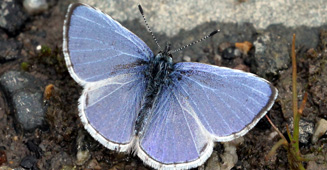

Contributor
- Topics: Archive

The Puget Sound region is home to 15 common butterflies, 14 of which are native species. Numerous species of native butterflies have become endangered in urban settings because of development, habitat fragmentation, and habitat degradation. It seems that community and backyard gardens could play a large role in providing much-needed habitat for urban butterflies, and many people are interested in creating butterfly gardens to attract them. What can you do to ensure that your butterfly garden is a safe haven for butterflies and other beneficial insects?
Butterflies belong to the family Lepidoptera, the scale-winged insect family that includes moths, butterflies, and skippers. They comprise about 17,000 of the 155,000 known species, and Lepidoptera live on every continent except Antarctica. Butterflies are charismatic insects and, as with the bees, people are becoming more aware that as pollinator habitat is disappearing, so are the butterflies.

Seattle Backyard Wildlife Sanctuary
Though there are 15 common butterflies in the Puget Sound eco-region, I have only seen three in my yard and only the imported Cabbage White (Pieris rapae) is a regular. On occasion a Western Tiger Swallowtail (Papilio rutulus) flutters over but does not stop to dine, and Woodland skippers (Ochlodes sylavanoides) frequently enjoy our grasses and herbs. The lack of butterfly diversity surprises me, because over the last 20 years we have created a Backyard Wildlife Sanctuary that appears to have all the “right stuff.” Regular visitors to our garden include five species of bumblebee, mason bees, honeybees, numerous moths, 25 species of birds, and countless other wild creatures. But, aside from the ubiquitous Cabbage White, rarely is a butterfly seen in our backyard habitat…so, what are we missing? Where are the butterflies? I wondered if this was typical for an urban garden and decided to cast my “butterfly net” a bit further afield.

My first visit was with Janice Murphy, Seattle University’s Integrated Pest Management specialist; Janice oversees SU’s 50 acres, which includes 14 gardens. SU has been chemical pesticide-free since 1979 and is an Urban Wildlife Sanctuary. I was dismayed to hear that the only butterfly regularly seen on the SU campus is the Cabbage White; in fact, no native butterfly sightings have been documented in SU’s Wildlife Garden or nectar patch. Janice was as baffled as I was, and we both were curious if this was happening in other urban areas.

Scientific Study Sleuthing
• In a 2010 study carried out in the Bronx and East Harlem, butterflies were counted in 18 community gardens over the course of three summers; over 3300 butterflies were tallied and 88 percent of them were Cabbage White butterflies. Unfortunately, and unsurprisingly, the invasive Cabbage White butterfly thrives in recently disturbed areas.
• In a 2004 California study of Pipevine Swallowtail butterflies (Battus philenor), researchers compared gardens to undisturbed natural sites to see which were more successful. They found that butterflies visited gardens that were well established, between 8 to 40 years old, but the survival of larvae was much lower than in natural sites. In fact, disturbingly, the evidence showed that many gardens were acting as population sinks or “death traps” for the Pipevine Swallowtail, not as refugia.
• A 2003 Pipevine Swallowtail study in the San Francisco Bay area found that, overall, butterfly species extinctions in San Francisco County are estimated to be as high as 43 percent. It was found that garden sites offered a smaller area of host plant coverage than a natural site, and that supplemental watering could affect egg survival. Notably, gardens planted in the last five years did not even receive butterfly visitation, and natural sites—in all areas tested—were always preferred.

Established Gardens as Refugia
In contrast to these studies, the nine-acre Hallberg Butterfly Gardens in West Sonoma County has been a sanctuary for the Pipevine Swallowtail for almost 100 years. The gardens include 80-year-old California Dutchman’s Pipevine (Aristolochia californica), which is the only host for the larvae. Hallberg garden caretakers realized early on that in order to provide a safe haven for butterflies, plants must be available throughout the butterfly’s lifecycle: egg, caterpillar, pupa, and butterfly. A critical habitat element to ensure safety is undisturbed shelter; this means that pruning, weeding, and tidying are done lightly, seasonally, and with extreme care.
When considering how to create urban butterfly refugia, it is important to take a long view on the process, as evidence shows that it is not as easy as “Plant it, and They Will Come.” My question led me to discover information that I have not read in any
butterfly garden manual. Though our garden is pesticide-free and has an abundance of native larval and host plants, that is not enough to provide safe haven for native butterflies—and the butterflies seem to sense it. This is important information for West Coast gardeners and designers wishing to create a butterfly garden, as it is highly likely that the majority of butterflies visiting will be the Cabbage White. Butterfly gardens should be created with the intention of providing safe havens for native butterflies, but changes in practice must take place to ensure that our gardens do not become death traps for Lepidoptera.
Though it may seem obvious, it is not just about the butterflies.

Bibliography
Connor, E., Hafernik, J., Levy, J., Moore, V., & Rickman, J. (2003). Insect Conservation in an Urban Biodiversity Hotspot: The San Francisco Bay Area. Journal of Insect Conservation 6
p. 247-259
Levy, J. M., & Connor, E. F. (2004). Are gardens effective in butterfly conservation? A case study with the pipevine swallowtail, Battus philenor. Journal Of Insect Conservation, 8(4), 323-330.
Matteson, K., & Langellotto, G. (2010).
Determinates of inner city butterfly and bee species richness. Urban Ecosystems










Responses